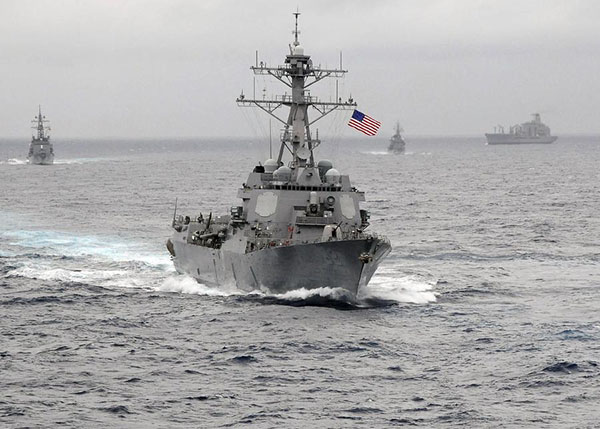Face-to-face meeting can chart safer course
Updated: 2016-07-19 07:45
(China Daily)
|
||||||||
 |
|
The US Navy guided-missile destroyer USS Lassen sails in the Pacific Ocean in a November 2009 photo provided by the US Navy. [Photo/Agencies] |
The ongoing three-day visit by US Chief of Naval Operations John Richardson to China, which started on Sunday, comes at a sensitive time, following an arbitral tribunal ruling last week that seeks to invalidate China's historic claims in the South China Sea.
The impulse of the United States and some of its allies, such as Japan, is to insist the ruling is legally binding and to enforce it with patrols in the name of "freedom of navigation".
But using military force to make China succumb to "a scrap of paper" that it neither accepts nor acknowledges will be of no avail. Although China desires peace and is committed to peaceful settlement to the South China Sea disputes, there will be no room for compromise on an issue that concerns its core national interests.
So the Chinese navy must be ready for any military provocations that challenge the country's sovereignty.
The US continues to stir up trouble by pointing accusing fingers at China's reclamation work on its islands and reefs, claiming it is militarizing the region.
Beijing insists the projects are for civilian purposes and the public good, and says it has exercised restraint when the US has repeatedly and provocatively sent its warships near and around its islands in so-called freedom of navigation patrols.
What China's next step will be in regard to its island reclamation work will depend on how serious its interests there are threatened. Saber rattling or use of force will definitely draw tit-for-tat responses.
Yet China has reiterated it safeguards freedom of navigation and overflight in the South China Sea and does not seek to challenge US primacy in the Asia-Pacific.
This is the foundation for both sides to seek a peaceful solution to the South China Sea issue, which can be achieved through face-to-face communications.
Sino-US military interactions have become more mature and professional, especially after the signing of rules of behavior for the safety of air and maritime encounters in 2014.
Undoubtedly, Richardson's sitting down together with his Chinese counterpart, Admiral Wu Shengli, commander of the Chinese navy, and exchanging views even disagreements is conducive to finding out how the two navies can manage the risks that may result from escalated tensions in the region.
This is an issue of increasing urgency. Neither side can afford any miscalculation or misjudgment, for it could pit them against each other militarily.
Hopefully, Richardson will get the message.
- African Union opens with launch of continental passport
- Baton Rouge shooter identified as ex-Marine Gavin Long
- Navy chiefs set for fresh talks on South China Sea
- Arrests hit 6,000 as Turkey cracks down on army and judges after coup bid
- A close look at Theresa May's new cabinet
- More than 70 dead in Nice attack as France marks national day

 Uphill battle for cyclists in downhill race in Zhangjiajie
Uphill battle for cyclists in downhill race in Zhangjiajie
 Shennongjia added to World Heritage List
Shennongjia added to World Heritage List
 Campers sleep perched on cliff face in Central China
Campers sleep perched on cliff face in Central China
 Two giant pandas meet public in NE China
Two giant pandas meet public in NE China
 Ongkor Festival celebrated in Southwest China's Tibet
Ongkor Festival celebrated in Southwest China's Tibet
 The world in photos: July 11 - 17
The world in photos: July 11 - 17
 Ten photos from around China: July 8-14
Ten photos from around China: July 8-14
 The only surviving panda triplets weaned from milk
The only surviving panda triplets weaned from milk
Most Viewed
Editor's Picks

|

|

|

|

|

|
Today's Top News
Ministry slams US-Korean THAAD deployment
Two police officers shot at protest in Dallas
Abe's blame game reveals his policies failing to get results
Ending wildlife trafficking must be policy priority in Asia
Effects of supply-side reform take time to be seen
Chinese State Councilor Yang Jiechi to meet Kerry
Chinese stocks surge on back of MSCI rumors
Liang avoids jail in shooting death
US Weekly

|

|








